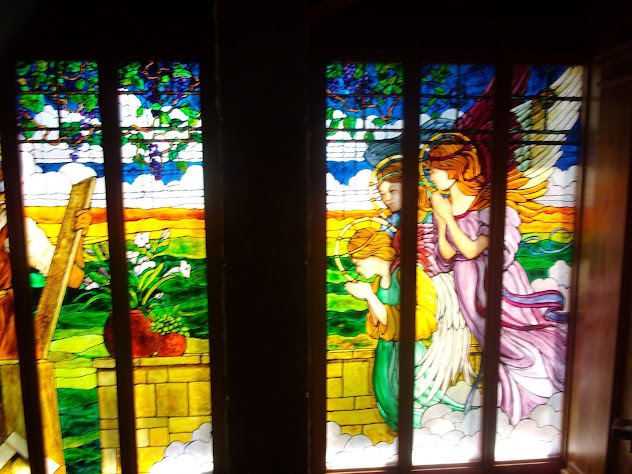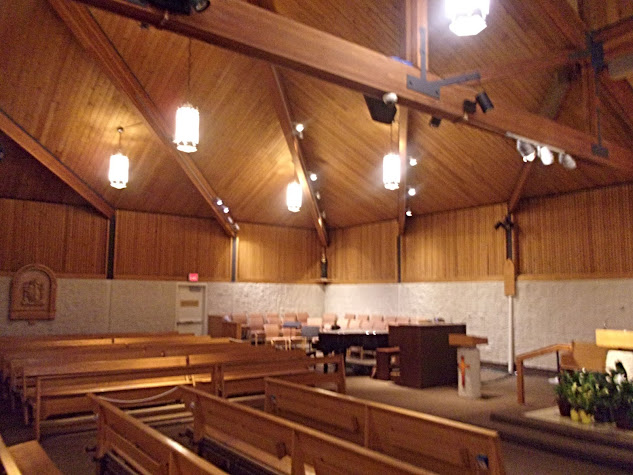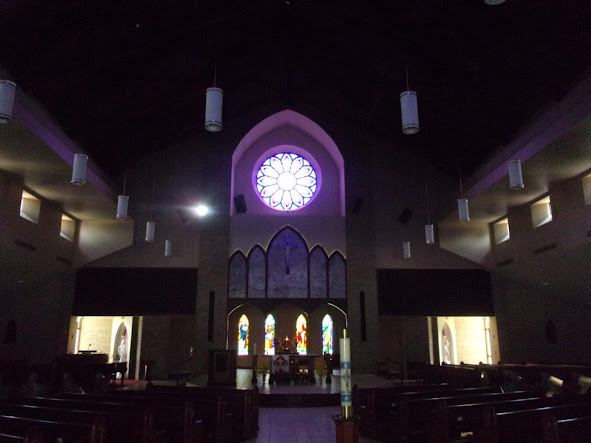Saint Thomas the Apostle
Elkhart, Indiana
The parish church of Saint Thomas the Apostle in Elkhart, Indiana was built in the 1962. The parish itself was founded in 1949, to accommodate the growing Catholic population of nearby Saint Vincent de Paul's.
While the parish looks ever so typical post Vatican II style, believe it or not it was built before the council even occurred. In fact it's built in a traditional Italian style, is style, albeit with very sixties techniques. It is a hallmark in traditional Italian churches, to have the bell tower, baptistry, and church, be their own separate entities. The leaning tower of Pisa is an example. It's a bell tower for the nearby church.
In the foreground to the right, is the rectory attached to the church. Most likely the Bells in the bell tower, are simply cut outs/models of real bells, while hidden somewhere else are speakers that play canned bell noises. Again, this is a Hallmark of the sixties and seventies as canned bell noises are drastically different than the real sound, and very easy to distinguish.
On the extreme far left is the original baptistry. Now moved, the baptistry in the rear of the church is a common feature in most pre-Vatican II churches. Every summer, on the feast of Corpus Christi there is a procession with the Blessed Sacrament from this church, to Saint Vincent's a mere two miles away, through downtown Elkhart.
An odd photo of the entrance doors. The polygon stained glass is consistent throughout the entire church.
A classic Catholic devotion is that of the Infant of Prague. The original statue belonged to Saint Teresa of Avila and after her death miracles began being attributed to the statue. Its devotion was popular amongst Polish Catholics, especially in the U.S.
Used now as a pseudo storage/seating area, this room originally served at the baptistry. This room differed from the rest of the church as the lighting was significantly less than in the rest of the church.
The church has several trademarks, common to church architecture of the sixties. Overbearingly long pews that could seat practically an entire army regiment, large blank spaces that could be seen as blank canvases (the ceiling), a very similar color palate, The mosaic was added later to the church in the 1960's
The windows along the aisle were sadly very polygon oriented. At this point in the development of churches, stained glass was a mixture of saints, biblical figures, and religious symbols, mixed with polygons. Traditionally stained glass was a medium of instruction as they were in use long before the printing press. In the multi-colored sheets of light, stories from the bible, precepts of the church, and miracles from the saints could all be conveyed for countless generations. This tradition continued up until the late fifties. The polygon stained glass that followed are simply plain, but again a canvas that can be built upon in later times.
On the backs of the pews was an old catholic 'doohickey'. Up to the mid-fifties, men traditionally wore hats, these clips would hold their hats or gloves in place.
An unfortunately blurry photo of the body of the church. The columns were common from the 60's to the 90's
A classic facet of confessionals was having the priest in the middle and having the penitents on either side. This was largely abandoned in the 70's as confessionals began to resemble grandma's living room. Thankfully Saint Thomas was spared this dated trend.
Another blurry photo. If there was any doubt of this parish being built before Vatican II, this communion rail should put those doubts to rest. After the conclusion of Vatican II, churches were built sans communion rails.
The sanctuary. Although in conformity with the practices of the Second Vatican Council, The altar used to be flush up against the back wall. Also note that the baptismal font is now off to the left, just off the sacristy.
The stations were very simple in style, typical of the era
The altar is very plain, but once again a blank canvas. Religious symbols could be engraved and or added. The tabernacle door is also very unique.
A surprise was the organ in the loft. Definitely not original to the church, it was most likely an addition to the church in recent years.

































































